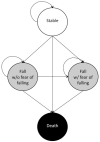Comparison of cost-effectiveness of vitamin D screening with that of universal supplementation in preventing falls in community-dwelling older adults
- PMID: 23631393
- PMCID: PMC3656128
- DOI: 10.1111/jgs.12213
Comparison of cost-effectiveness of vitamin D screening with that of universal supplementation in preventing falls in community-dwelling older adults
Abstract
Objectives: To compare the cost-effectiveness of population screening for vitamin D insufficiency with that of universal vitamin D supplementation in community-dwelling older adults.
Design: A Markov decision model simulating follow-up over a 36-month period. Published data were used to estimate values for the model, including costs (measured in 2011 U.S. dollars), utilities (measured in quality-adjusted life years (QALYs)), and probabilities.
Setting: Decision analysis simulation from a societal perspective.
Participants: Hypothetical cohort of community-dwelling women and men aged 65 to 80.
Measurements: Net monetary benefit (NMB) was calculated by subtracting the incremental cost of the strategy from the product of incremental QALYs and willingness-to-pay threshold. A higher NMB indicates greater cost-effectiveness.
Results: In women aged 65 to 80, population screening was slightly more cost-effective than universal supplementation, with an incremental NMB of $224 compared with $189 (P < .001). Population screening in men was also more cost-effective than universal supplementation (incremental NMB $298 vs $260, P < .001). Results differed according to age group. In those aged 65, population screening had cost-effectiveness similar to that of universal supplementation in women ($59 vs $71) and men ($114 vs $120), whereas in those aged 80, population screening was substantially more cost-effective than universal supplementation in women ($563 vs $428) and men ($703 vs $571).
Conclusion: Population screening and universal supplementation for vitamin D insufficiency are cost-effective strategies in community-dwelling older women and men. In the oldest old, population screening may be more cost-effective than universal supplementation.
© 2013, Copyright the Authors Journal compilation © 2013, The American Geriatrics Society.
Figures




References
-
- Tinetti ME. Clinical practice. Preventing falls in elderly persons. N Engl J Med. 2003;348:42–49. - PubMed
-
- Sattin RW, Lambert Huber DA, DeVito CA, et al. The incidence of fall injury events among the elderly in a defined population. Am J Epidemiol. 1990;131:1028–1037. - PubMed
-
- Sattin RW. Falls among older persons: A public health perspective. Annu Rev Public Health. 1992;13:489–508. - PubMed
Publication types
MeSH terms
Substances
Grants and funding
LinkOut - more resources
Full Text Sources
Other Literature Sources
Medical

